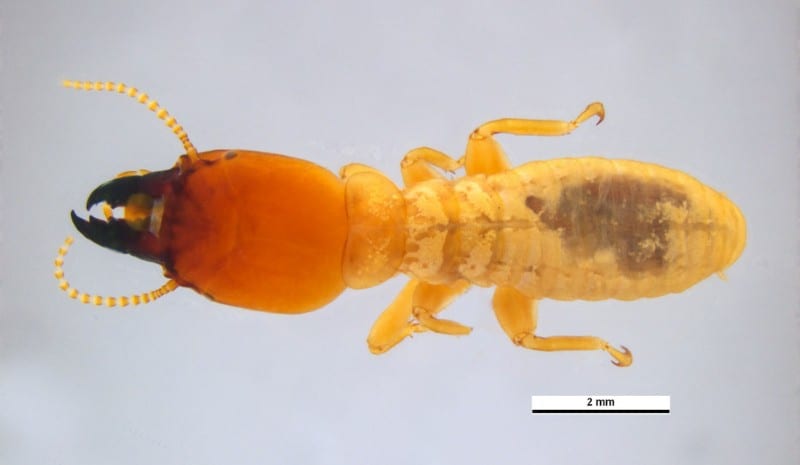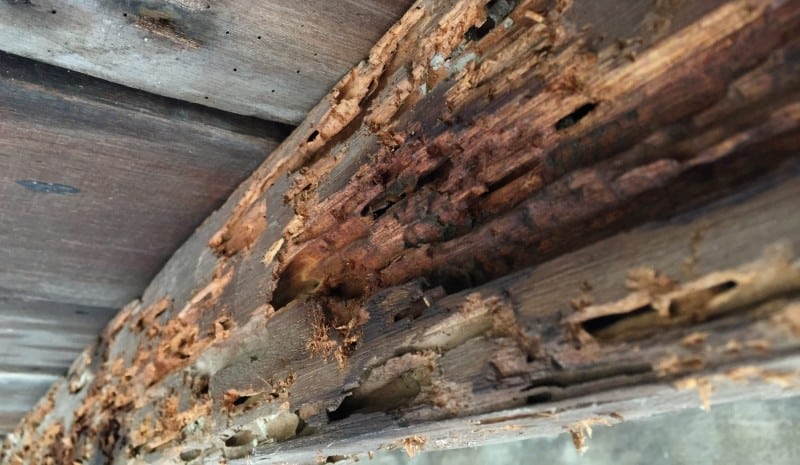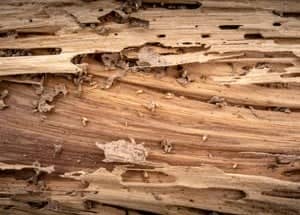Termites and Wood
As homeowners, many of us dread the thought of termites infesting our homes. These silent destroyers of wood can cause serious damage and require costly repairs. However, to effectively prevent or treat a termite infestation, it’s important to first understand the relationship between termites and wood. From what termites eat to how they digest wood, there is a lot to learn about these tiny creatures and their feeding patterns. In this section, we’ll explore the fascinating way termites interact with wood and the effects of their digestion on both the wood and our homes.
How Termites Digest Wood

Termites have evolved to be highly efficient at digesting wood. They have special gut microbes that are capable of breaking down the cellulose in wood, a process that many animals are unable to perform. Termites actually rely on these microbes to extract nutrition from the cellulose and other organic compounds in wood.
Here are some steps in more detail on how termites digest wood:
- Feeding: Termites feed on wood using their strong jaws and saliva that contains enzymes that begin the breakdown of wood.
- Entry to the gut: The wood passes through the termite’s digestive system and enters the midgut, where many different species of gut microbes reside.
- Deconstruction: The cellulose in the wood is deconstructed by enzymes produced by the microbes. The microbes also break down other organic compounds in the wood, such as lignin and hemicellulose.
- Nutrient Extraction: Nutrient extraction is carried out by the microbes, which produce short-chain fatty acids and other useful nutrients that the termite can absorb and use for energy.
Why Termites Target Wood in Homes
Termites are known to target wood in homes due to their specific diet, behavior, and living conditions. Termites mainly feed on the cellulose found in wood, which is broken down by enzymes produced by microbes in their gut. This allows them to digest the cellulose and extract the nutrients they need to survive.
Subterranean termites, which are the most common type of termite found in homes, primarily feed on wood that is in direct contact with the soil. This is because they need a moisture-rich environment to survive. They create mud tubes in order to access wood and other sources of cellulose without exposing themselves to open air conditions. They tend to feed on wood that is soft and more nutritionally rich in cellulose, such as decayed or water-damaged wood.
Drywood termites, on the other hand, do not require moisture to survive. They tend to infest dry, sound wood in homes and cause significant damage if they are left untreated. Unlike subterranean termites, drywood termites do not build mud tubes and can enter homes through small cracks and crevices in the structure.
Dampwood termites infest wood that is wet, decaying or fungus-infested. They prefer to feed on hardwoods and are common in areas with high levels of moisture, like the Pacific Northwest.
Termites will continue to target wood in homes due to a combination of their biology, behavior, and living environment. Not only does their specific diet require them to consume cellulose, but they also require a moisture-rich environment to survive. This means that wood in contact with soil, wood that is damp or decaying and wood in hard-to-reach locations (like wall voids) are highly susceptible to infestation.
The Effects of Termite Digestion on Wood
The actions of termites may seem insignificant, but the effects of their digestion on wood prove otherwise. Understanding how these tiny pests digest wood can help homeowners identify potential infestations and take preventative measures to protect their properties. It’s important to note that not all termites target the same type of wood. For example, drywood and dampwood termites have unique diets that affect the way they interact with wood differently. Additionally, gut microbes play a crucial role in termite digestion, which helps explain why they can cause such extensive damage. In this section, we’ll explore the physical and structural changes that result from termite digestion and provide some guidance on what to look out for.
Physical Changes to Wood
During digestion, termites transform the physical structure of wood. The wood they consume becomes softer, loses its strength and changes color. These physical changes are caused by the breakdown of wood fibers into simple sugars, which are absorbed by the termite’s gut microbes.
Softening of Wood
As termites feed on wood, the cellulose fibers within the wood are broken down into smaller components through the process of hydrolysis. This releases water and causes the wood to soften and become spongy. Walls and other wooden structures in buildings can sag or warp due to this softening of the wood. The floor can also become uneven, and doors may not open or close properly.
Loss of Strength
Termites can reduce the strength of wood by attacking its surface. They feed on the softer spring wood that surrounds the harder summer wood, leaving behind a honeycomb-like structure that is weaker than the original wood. This reduced strength can compromise the structural stability of wooden buildings, making them unsafe.
Changes in Color
Termites can change the color of the interior of the wood from light to dark. This is because during digestion, the termites convert some of the compounds within the wood to pigments that give the wood a darker color. The area around termite galleries may have a distinctive brown or black color compared to the surrounding wood.
If termite damage is left untreated, the physical changes to the wood can result in significant structural damage and expensive repairs. It is important to identify and treat termite infestations before they cause significant damage.
To learn more about the diet and behavior of termites and their impact on the landscape, please click on the following link: termite diet behavior impact.
Structural Damage to Homes

Termites can cause significant structural damage to homes, and this can lead to costly repairs. The extent of structural damage depends on the type of termite, the size of the colony, and the duration of the infestation. Termites primarily target wood as their primary source of food, and with time they can weaken the structural integrity of a building.
During an infestation, termites eat through wood, leaving behind hollow cavities that weaken the wood. This can cause floors and walls to sag, and in severe cases, the entire structure may collapse. In fact, according to the National Pest Management Association, termites cause over five billion dollars in property damage in the United States each year.
Subterranean termites, which live in the soil and build mud tubes to access above-ground food sources, are particularly destructive. They often target wood that is in direct contact with soil, such as basement joists, porch posts, and door frames. They can cause extensive damage before it becomes visible on the surface.
Drywood termites do not require soil contact and commonly infest exposed wood such as attics and external woodwork. They tend to create small, yet complex, networks of tunnels that can run through an entire piece of wood. Once they have infested an area, they can continue to cause damage until the wood is completely consumed.
To better understand the extent of structural damage, it’s important to know the signs of a termite infestation. These include warped or sagging floors, buckling wallpaper, and walls that sound hollow when tapped. Additionally, you may notice small piles of wood pellets or wings that have been shed by adult termites.
If left untreated, a termite infestation can cause structural damage that requires major repairs. In some cases, homeowners may need to replace entire sections of their home due to termite damage. It’s essential to identify and treat termite infestations as early as possible to minimize the likelihood of prolonged structural damage.
Conclusion
After understanding the complex relationship between termites and wood, it is clear that prevention and early detection are key to avoiding the devastating effects of a termite infestation. Whether you are a homeowner or a business owner with a wooden structure in need of protection, taking preventative measures can save you time, money, and stress in the long run.
Finally, keep in mind that understanding the relationship between termites and wood is the first step in protecting your property. By staying informed and taking preventative measures, you can maintain the integrity of your wooden structures and avoid falling victim to a costly termite infestation.
Frequently Asked Questions
1. Why do termites target wood?
Termites target wood as it contains cellulose and other nutrients that are necessary for their survival and growth.
2. Can termites digest other materials besides wood?
Yes, termites can also digest materials like paper, cardboard, and even fabric that contain cellulose.
3. How do termites digest wood?
Termites have special bacteria in their gut that produce enzymes to break down the cellulose in wood into simpler compounds that they can digest.
4. What physical changes occur in wood due to termite digestion?
Termite digestion can cause wood to become discolored, soft, and weak. In severe cases, the wood may even crumble or break apart.
5. How can termite damage affect the structural integrity of a home?
Termite damage can weaken important load-bearing structures like beams and floor joists in a home, causing them to sag or even collapse over time.
6. What are some visual signs of a termite infestation?
Visual signs of a termite infestation include discarded wings, termite droppings (also known as frass), and mud tubes or tunnels on the exterior of a home.
7. What are some audible signs of a termite infestation?
While termites themselves are not noisy, they may cause hollow-sounding wood or clicking noises if they are eating away at it inside of walls or floors.
8. Are there any natural methods for preventing termite infestations?
Yes, some natural methods for preventing termite infestations include using nematodes or certain types of wood like cedar or redwood that are resistant to termite damage.
9. What are some treatment options for a termite infestation?
Treatment options for a termite infestation may include liquid termiticides, termite baits, or fumigation with gas.
10. How can I prevent future termite infestations in my home?
Some ways to prevent future termite infestations include regularly inspecting your home for signs of termites, removing any wood debris or other cellulose materials near your home, and sealing any cracks or crevices where termites may gain entry.

